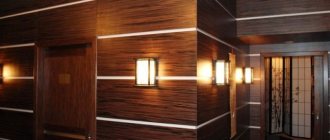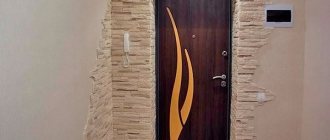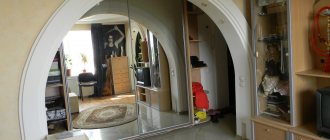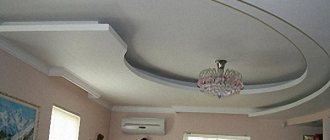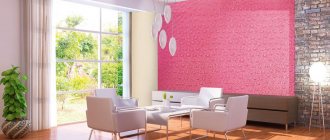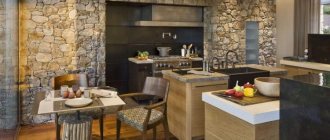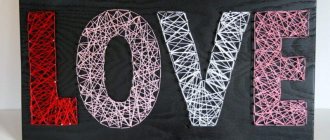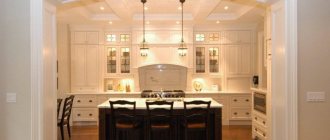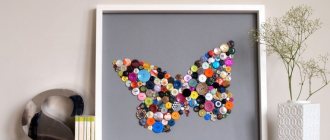Sheathing materials
Purely decorative techniques are not suitable for restoring the surface of the door, since they are cosmetic in nature, especially when it comes to the entrance door leaf, which is exposed to the most intense effects of temperature and moisture. Finishing the sash with appropriate materials will not only restore the attractiveness of the product, but also improve its sound and heat insulation properties.
- Laminate – finishing boards 7–8 mm thick, made from high-density wood-fiber boards. The back side of the lamella is covered with a layer of waterproof paper, and the front side is covered with a moisture-proof film and a decorative layer. Laminate imitates the look of wood, stone, ceramics, which allows you to choose options to suit any interior. The material is characterized by good sound and heat insulation properties, but is quite hygroscopic, therefore it is used more often for interior cladding.
Finishing lamellas have gained great popularity due to their very affordable cost and durability. They are extremely undemanding in care - just wiping with water or mild detergents is enough.
- Lining - narrow wooden slats with special grooves for strong and easy fastening. The thickness of the products ranges from 6 to 20 mm, the length is 1.5, 3 and 6 m. During production, they are treated with antiseptic agents. The level of sound and heat insulation of the lining is significantly higher, and hygroscopicity is lower.
For external work, it is recommended to use boards made of coniferous wood - pine, larch; for internal work, more valuable species are used - cedar, ash, beech. The products retain the natural color and pattern of the wood, which adds a lot to the beauty of the front door.
- MDF panels are produced by pressing small wood chips. To cover the door leaf, a 16 mm thick plate is used, covered with a polyvinyl chloride film or anti-vandal. The material is characterized by mechanical strength and high heat and sound insulation, is not susceptible to fungi and is resistant to moisture.
- Plastic – narrow lamellas are made of polyvinyl chloride with special additives that increase the material’s resistance to low temperatures, moisture and ultraviolet radiation. The panels are extremely low maintenance, durable and easy to install. However, the mechanical strength of the material is low, so it is recommended to use it for interior work.
The panels are available in two versions: seamless and suture, in the form of lining.
MDF door trim
MDF door linings are increasingly used in cladding various surfaces and upholstering entrance doors. And this is not at all surprising. Many people still confuse MDF panels with PVC panels. Of course, they are somewhat similar to each other.
But, these panels are made from wood chips, pressed and bonded with special substances. In this case, a special hot pressing technology is used. That is why they are a high-quality, environmentally friendly product that is safe for people. After all, they do not contain resins and phenol.
It is not surprising that many today prefer MDF panels. And it is this material that is becoming increasingly popular. At the dawn of the appearance of metal doors, no one thought that steel could be made to look like wood. But it turned out that it was possible - so MDF panels with various coatings appeared (or, as they are called differently, door overlays). What could be more valuable and beautiful than natural things? Only natural. But since not everyone can afford to finish a door with natural solid wood, for example, oak, manufacturers decided to take into account the requirements of customers who value beauty and grace and, to their delight, created a whole range of materials that are as close as possible in appearance to wood.
In addition, finishing doors with MDF panels is characterized by ease of installation. And, importantly, the ease of dismantling one damaged or all panels if the need arises. MDF panels are easy to use. Wash with a simple damp cloth. They are durable and environmentally friendly.
In addition to all of the above, MDF panels have an original appearance and a rich range of colors. They have different facade coatings: PVC film, ICSAM paint, natural wood veneer. At the same time, you can choose the most suitable option for you in terms of color, pattern and milling.
| PVC film samples | Veneer samples | ICSAM paint | Samples of panel milling |
ATTENTION : The MDF panel for the door is made strictly according to the dimensions of the door leaf. Production time is 3-4 days.
Installing an MDF panel to replace damaged leatherette? This is an advanced solution in choosing the finish for your door.
Unfortunately, in our lives there are enough hooligans who are happy to burn, cut, in a word, render the door trim unusable. Very often we are disappointed by our pets. With their sharp claws they reduce the upholstery on the door to the state of rags. In the 21st century, salvation from these scourges appeared. This is the installation of an MDF panel.
How to cover doors with laminate
Sheathing a door leaf with laminate can be done very quickly and easily, since the material is simply glued to the surface of the leaf.
- The door is removed from its hinges for ease of operation and placed on a flat surface.
- Locks, door handles and peepholes, if any, are temporarily removed.
- Laminate boards are cut to size.
- An adhesive composition is applied to the surface of each lamella - liquid nails or Moment glue, for example. The lamellas are placed on the canvas, lightly pressed down and left until completely set.
Please note that the material itself does not bridge the gap between the sash and the door frame. If sealing material was placed around the perimeter of the canvas, it should be restored.
The video shows a video with instructions.
Installation technology
MDF panels for metal doors are mounted using a fairly simple technology:
- To do the job most efficiently, you should remove the canvas. This method will allow you to avoid distortions that may appear if you try to carry out the process by weight. All protruding elements are removed from the part.
Before starting finishing work, it is necessary to remove the door leaf from the hinges
- The canvas is laid on a flat and stable surface.
- It all starts with sanding all areas well. It is necessary to remove old paint and possible traces of corrosion. Next comes cleaning and degreasing.
- Now you should prepare the panel itself. On the reverse side, it is wiped well to eliminate any contamination that could lead to peeling.
- Next, a special adhesive is applied to the door base. It is selected taking into account the materials used. It is distributed in waves, and all edges should be well coated.
On a note! If the work involves cladding wooden products, then many craftsmen advise, after removing the top layer, to stick a vinyl film on the surface, which will increase adhesion.
The choice of glue should be approached very carefully, otherwise all the work may be in vain
It is necessary to take into account that a significant problem may arise - the handles do not fall into place. This will mean that the thickness of the overlays is chosen incorrectly. But it happens that it is impossible to find another one. Then the holes for the handles are milled, which are recessed into the panel.
Source: otdelkagid.ru
How to sheathe MDF boards
This is the most expensive finishing method, but also the most durable. It is usually used when decorating steel entrance doors. MDF panels can be installed either directly on the surface of a steel sheet or on existing cladding - leatherette, for example.
- Holes are drilled around the perimeter of the vestibule - that part of the sash that covers the door frame. The step is 20 cm.
- Along the perimeter of the canvas itself, a series of through holes are drilled through both steel sheets in increments of 20 cm. The diameter is 3 mm, the same as in the previous case.
- The inner MDF cover is fixed with screws, and then the outer one. The length of the screw should be a couple of millimeters less than the thickness of the sheet.
- The door fittings removed for the duration of the work are being installed.
Since the MDF panel usually represents the entire facade of the door, it is recommended to invite an assistant to install it.
MDF door finishing options
Panels can be covered not only with a film of melamine paper; for this, manufacturers use veneer of expensive wood species or laminate - artificial veneer. This not only expands the product range, but also allows you to select a model for an exclusive exterior. Natural veneer glued onto an MDF panel requires careful care. Its advantage is the unique design of each door, since the cut of natural wood has its own characteristic pattern.
If the exclusive nature of the finish is not of interest, but there is a desire to have a finish that maximally imitates natural wood, then it is better to use laminate for cladding MDF panels. This material is made of thick PVC, it is durable, easy to care for, and can be washed using household chemicals. The significant thickness allows you to clearly draw the texture of natural wood. Thanks to this, it is difficult even for a professional to distinguish artificial veneer from natural one.
How to cover doors with clapboard
It is recommended to first keep the material in the room for 2-3 days for acclimatization.
- The door leaf is removed from its hinges and laid on a flat surface. The fittings are removed.
- The lining is cut in accordance with the parameters of the door and the installation method: vertically, horizontally, diagonally, or even in the form of some kind of pattern.
- Sheathing begins from the edge - depending on the method, sequentially connecting the elements together and securing them with finishing nails.
- After installation is completed, the surface of the material is varnished.
If you need to sheathe a metal sheet, then at the first stage you should attach the sheathing. Narrow wooden slats are secured with self-tapping screws, and wooden slats are mounted on them. You can use special gluers to attach the panel to the surface of a steel sheet, but this method fixes the lining quite rigidly, and subsequently the material can be deformed.
Source: dvernoigid.ru
Door slopes made of MDF on slats
If the width of the slope is large (more than 25 cm), additional supports are required for rigidity: the foam may not be dense enough. In this case, the planks are secured. These can be lumber or metal profiles. The planks can be attached vertically or horizontally. The installation diagram for a slope made of MDF panels with vertical slats is shown in the photo below.
How to attach wide MDF slopes
The planks are attached to dowels (they are used more often) or self-tapping screws, depending on the wall material. After the supports are secured, the slopes are cut to size, the procedure is similar. First, the ends and places where the slope is adjacent to the planks are coated with liquid nails, and the panels are peeled off for a few minutes. Further all actions are exactly the same.
If, as in the figure, the junction of the panel and the wall is ideal, you can do without foaming the cracks and installing platbands. In this case there is not much work at all.
Door slopes made of MDF can be installed on horizontal strips. They are aligned so that they are all in the same plane. On the sides, four supports are enough, at the top - three (10-15 cm away from the edges and in the middle). Further, all the technology is the same.
Why is this necessary?
It is necessary to trim the slopes of the doorway. First of all, to create an aesthetic appearance, because when removing the old box, the slopes were probably damaged. The next reason is the need to hide the installation process. The polyurethane foam doesn't look the best.
Note! If the polyurethane foam is not hidden from direct sunlight, it will literally crumble in 3-4 years. If it comes to the front door, then this is fraught with, at a minimum, the formation of drafts, and at a maximum, easy penetration of intruders into the house.
The designed slope must meet certain criteria:
- no condensation formation;
- aesthetic appearance;
- improving door thermal insulation;
- resistance to temperature changes;
- easy care and washing without loss of appearance.
Opening type
It’s clear why the opening needs to be sheathed, but not all of them are standard; there are many options. Coming out of this, the finishing materials also differ. Options:
- Rectangular opening. Sheathed with any material, including plastic panels. Moreover, it can be not just a place of passage to another room or into the house, but an important part of the design solution of the room.
- Arch. This option is not used in every room, as it is appropriate only in some styles. This solution is suitable if the rooms are decorated the same way and there is no need to physically separate them. For finishing, you should choose materials that do not stand out too much from the background of the rest of the room, otherwise they will “weight down” the opening. It is interesting that in modern interiors, in addition to classic rounded arches, ellipsoidal, trapezoidal, and even asymmetrical arches are created. They can be easily finished with plastic panels, which cannot be said about tiles.
- Imitation of an arch. This method is also called lazy, because an “arched” finish is formed in an ordinary rectangular opening; it will not be difficult to complete.
- A doorway without a door. It’s easiest to install the finishing here, but the main task in this case is to choose the right material, then the finished opening will look organic.
Slope finished with plastic panels
Types of finishes
- Lamination – most often smooth sheets that imitate the texture and shade of natural wood;
- PVC films – have anti-vandal properties and impact resistance. Resistant to temperature and humidity fluctuations;
- Paint and varnish are applied in several layers, which has a positive effect on practical performance. Allows you to create products of various colors, including bright and unusual ones. This has a positive effect on the arrangement of some interiors;
- Veneer is a natural material. It is considered one of the most elegant solutions. It is fixed to the panel using specialized adhesives. They are distinguished by functionality and durability.
Alternative options
Other options for finishing the doorway:
- Tile. The method is practical, however, not the most convenient. You will have to carefully consider the choice of tiles, and the question also arises of how to lay it over the doorway, despite the fact that it is important to ensure the adhesion of the adhesive. And laying tiles without certain skills is difficult.
- Artificial stone - this option will create excellent aesthetics, but even during the first attempts to wash it, this beauty will fade in the eyes of the owner, since such materials often have a fairly deep structure.
- Decorative plaster. It looks original, fresh, unusual, but only if it was applied by a specialist.
Different types of material
There are various panels for door trim. They differ in appearance, which must be taken into account in each specific situation. Depending on needs, the cladding can be as follows:
- Covered with natural veneer.
- With a layer of lamination applied.
- With a vandal-resistant plastic surface.
For door trim, you can choose MDF with different coatings.
On a note! All options are available in sizes that fit standard door dimensions. If the design has other parameters, then the overlay will need to be made to order.
Veneered panels
The material is distinguished by the fact that its surface is covered with a thin cut of wood. The use of such panels allows you to completely transform the doorway. It takes on a more noble and respectable appearance. Naturally, such products have a lower cost than natural wood.
The following advantages of veneer should be noted:
- Excellent decorative options. Indeed, the look of natural wood is very difficult to compete with.
- Environmentally friendly. Considering that the MDF base is completely safe, in combination with veneer this is the best solution.
- Good resistance to various types of damage.
Veneered MDF panels are an environmentally friendly material that is resistant to damage
There are also some disadvantages:
- The surface must not be maintained with abrasive substances. If you allow them to be used, the coating will become covered with numerous scratches.
- Peeling at high humidity limits the scope of use.
- Exposure to direct sunlight is an undesirable factor that can lead to defects.
On a note! The veneered option is excellent for apartment buildings, as well as private buildings, provided that the door does not come into direct contact with the outdoor environment.
Door with veneered MDF finish
Laminated panels
Products are obtained by applying a special laminating film to an MDF board. This method makes it possible to produce panels that are inexpensive. It should be noted that the technology makes it possible to imitate almost any texture. Although there are the following varieties:
- Completely smooth.
- With relief milling.
- With inserts that can be made in different colors.
This material has many advantages:
- A large number of design solutions. This makes it possible to choose the most optimal option for each interior.
- Creating additional sound insulation.
- Durability. The service life can be decades.
Laminated MDF is a very practical and durable material
It is also necessary to note the disadvantages, which are expressed in the fact that the product is unstable in high humidity, and, in addition, does not tolerate constant temperature fluctuations.
On a note! Laminated MDF panels are used only for finishing the surface of entrance doors that are located indoors. Such products are a more economical alternative to veneer.
Laminated panels allow you to create an excellent decorative coating
Anti-vandal panels
This material is produced by a method that involves covering a wood fiber sheet with a laminated plastic. The coating turns out to be very reliable. Although this product has many other positive factors.
Among them are:
- Very high strength. The surface is characterized by almost perfect resistance to mechanical stress.
- Resistance to ultraviolet radiation and high temperatures.
- Often, there is a complete absence of damage if chemicals enter.
Indeed, this option does not even have any particular disadvantages. But it is important to understand that the price of the product can be very high.
On a note! This type is ideal for finishing the outside of a door that interacts with the outside environment. Due to the fact that such a surface is very difficult to damage, it is called anti-vandal.
PVC panels are the best choice
This option is optimal, because this finish combines an affordable price, ease of installation and an attractive appearance. Manufacturers offer a variety of panel options to imitate natural materials; wood is especially popular. This material has a number of significant advantages:
- Environmentally friendly. The surface of the panels has no pores, which prevents the fixation and development of fungi and mold on it. When it comes to the slope of the front door, this is important.
- Fire resistance. If we compare it with other popular materials - fiberboard and chipboard, then PVC products have a ignition temperature that is 100 degrees higher. Even if a fire occurs, the panel emits less smoke than the specified materials, which means it will not create an obstacle to exiting the room. Plus, PVC is a self-extinguishing material.
- Durability. The panels can withstand intensive use, temperature changes, and repeated washing.
- Ease of installation - attaching them to the wall will not be difficult even for a novice builder.
- The doorway takes on a finished look.
Slopes finished with white panels
Advice! If the opening is wide, many people wonder what is better: installing a second door or finishing this space? The decision depends on the location of the opening itself. For the entrance group, two doors are still preferable.
Advantages of MDF finishing
MDF is a medium-density wood-fiber board used for finishing the front door outside and inside. Suitable for cladding doors made of iron, metal and steel - even steel doors with MDF finishing look amazing, impressing the most demanding aesthetes.
Why should you give preference to this particular material?
- Wide choose. Modern manufacturers willingly please the consumer by providing us with numerous options with a variety of colors and textures. It is possible to finish with materials that imitate natural ones - thus, entrance doors with MDF finishing acquire an elegant appearance. Design options are widely presented in the photographs provided by the manufacturer - choose your unique option, completely transforming the appearance of the hallway.
- Durability. Wood-fiber materials will retain their presentable appearance and useful qualities for many years. They perfectly tolerate various mechanical loads and are not afraid of temperature changes and sunlight. Compared to upholstery made from leatherette (easily torn and fading before our eyes), MDF boasts a combination of beauty and practicality.
- Safety. The panels contain absolutely no substances that can harm human health, unlike some other facing materials.
- Easy care. No difficulties are expected - forget about expensive detergents, delicate procedures - you just need to periodically wipe the panels with a damp cloth. In addition, MDF does not absorb unpleasant household odors at all - no additional care is required.
- Ease of installation. It is possible to finish with MDF panels without involving specialists. All you need is the necessary tools and extreme accuracy, then finishing the MDF door will be quick and successful.
- Sound insulation and thermal insulation. The materials will provide you with a cozy, warm hallway - it is possible to add a layer of insulation on the outside.
- Acceptable price. Depends on the specific type of panels, however, in general, they belong to the average price category.
- Possibility to install slopes made of similar material.
Related article: Technology of laying wooden floors in modern conditions
Installation of panels: preparation
Preparation consists of studying the technology of work behavior:
- The first step is to clear the opening from any remaining finishing.
- Next comes plaster. This step is optional, but it makes it easier to install the panels; provided the alignment is good, you can do without lathing.
- Coating with a primer to prevent the development of fungi and mold under the panel, since it cannot be dismantled without losing its integrity.
- Next, the sheathing (if necessary) and PVC panels are installed.
Tools and materials that will be needed for work:
- Level.
- Electric drill or screwdriver.
- Self-tapping screws.
- Hand saw or jigsaw.
- Pencil.
Wood-look PVC slopes
Installation of sandwich panels
Such panels protect the doorway from the cold thanks to their multilayer structure. It contains foamed polystyrene with a closed cell structure, externally it is protected by a special rigid PVC film. Such panels are durable and resistant to ultraviolet radiation. They can be used to cover door slopes of any thickness - from 5 to 150 cm.
The panels are installed using dowels. The ends are closed with decorative corners. The joints with the box must be treated with a sealant of a suitable color.
Note! The sealant must have a PVC base, then it will not create a sticky effect, like silicone compounds.
Wall panels: installation
This material is also used for cladding, but wall panels are more fragile, so you need to handle them carefully. They are available in different lengths and widths. Mounted on a sheathing made of metal or wooden blocks. To improve heat and sound insulation performance, it is worth laying insulation on the slope. A decorative corner is installed at the joints.
Multi-colored plastic panels
Installation of slopes using a frame method
Slopes from fiber panels can be made using the frame and glue method. Do-it-yourself installation of slopes from MDF panels using a frame method is carried out using the following technology:
- Along the edges of the slope, both inside and outside, use dowels to secure wooden slats, which must be covered over time with MDF panels. The bars should be level. To avoid distortion of the structure between the skeleton and the opening, wedges must be driven in.
- Cut 3 sheets from MDF (2 for vertical mounting and 1 for horizontal mounting).
- The parts should be attached to the opening and points for cutting should be marked.
- Trimming should be done strictly to the size of the door opening.
Installation of wooden slopes
- Apply liquid nails to the inner edge of the panel and attach to the frame.
- The panels should be aligned so as to achieve a minimum gap between them.
- Fixation can be strengthened using self-tapping screws that are screwed into the upper and lower parts. The screw caps are decorated with special elements.
- The final point is attaching the platbands.
If the depth of the opening does not exceed the width of the MDF, then in this case it is possible to fix it in a seamless manner by installing it vertically.
